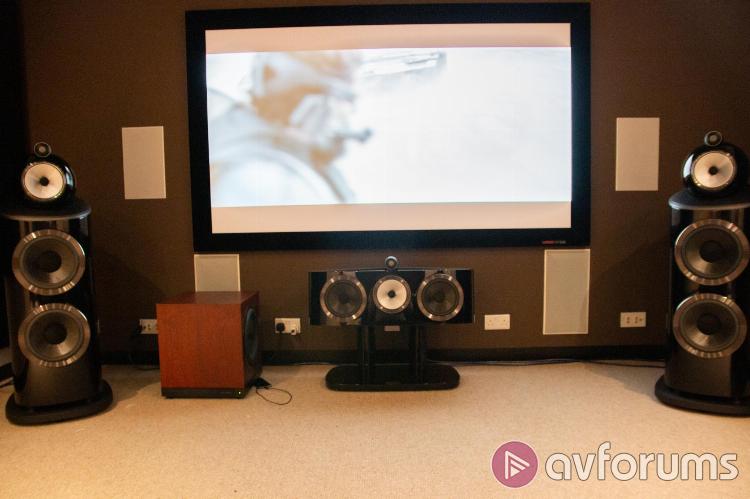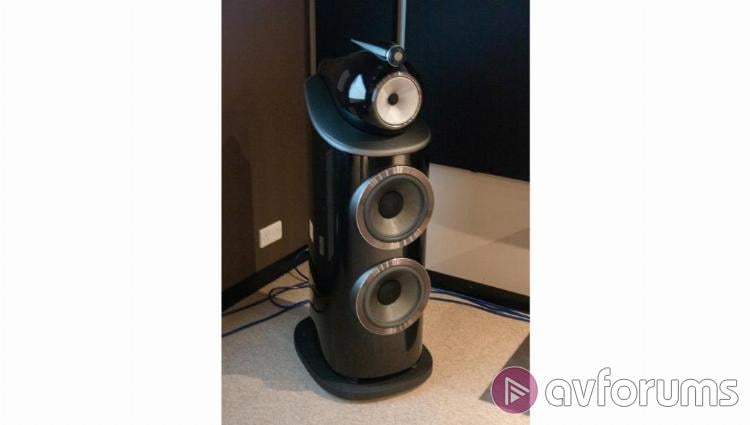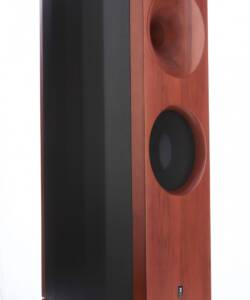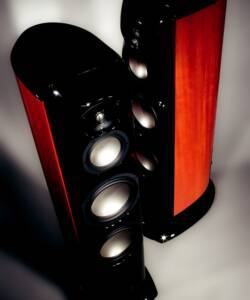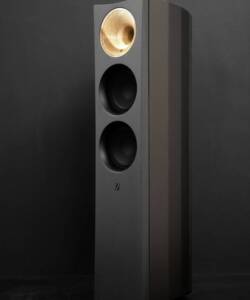Bowers & Wilkins HTM81 D4 [Piano Black]
Original price was: R190,000.00.R168,000.00Current price is: R168,000.00.
- Technical features –
- Diamond tweeter
- Solid-body Tweeter-on-Top
- Continuum™ cone FST
- Anti-Resonance plug
- Biomimetic Suspension
- Matrix™
- Aerofoil™ cone bass units
- Flowport
- Description – 3-way vented-box system
- Drive units –
- 1x ø25mm (1in) diamond dome high-frequency
- 1x ø150mm (6in) Continuum cone FST midrange
- 2x ø200mm (8in) Aerofoil cone bass units
- Frequency range – 20Hz to 35kHz
- Frequency response (+/-3dB from reference axis) – 28Hz to 28kHz
- Sensitivity (on-axis at 2.83Vrms at 1m) – 90dB
- Harmonic distortion –
- 2nd and 3rd harmonics (90dB,1m on-axis)
- <1% 80Hz – 20kHz
- <0.3% 100Hz – 20kHz
- Nominal impedance – 8Ω (minimum 3.0Ω)
- Recommended amplifier power – 50W – 500W into 8Ω on unclipped program
- Max. recommended cable impedance – 0.1Ω
- Dimensions –
- Height: 334mm (13.15″)
- Width: 847mm (33.35″)
- Depth: 371mm (14.61″)
- Net weight 32.20 kg (70.99 lbs)
Description
Bowers & Wilkins 800 Series AV System Review
Pros
- Simply outstanding integration, detail and space
- Surprisingly forgiving and easy to drive
- Beautifully made and finished
Cons
- Not everyone will want a box speaker in an AV room (although other options exist)
- Rather large
- Not cheap
Introduction – What Is the 800 Series AV System?
The Bowers & Wilkins 800 Series multichannel system is a revisit of the 800 Series (where we have looked at the 805D4 as a stereo speaker) but, this time, we’ve called in reinforcements. The 800 Series is relatively unusual in the world of high end speaker ranges because it has catered to multichannel for many of the generations it has existed in. The range of models offered for this purpose has actually declined a little over the years (we’ll cover why in due course) but this is still an example of a line up of models where you can choose a £32,500 floorstander for stereo purposes and proceed to integrate it into a cohesive multichannel arrangement.
Of course, while you can do this, you almost certainly can’t in the confines of my house. This has meant that I’m activating a new process to test the 800 Series; the offsite review. This is different from the ‘First Look’ process that we have used in the past in that I will reach a conclusion with score but it needs to be made clear that the room I reached these conclusions in was neither my own nor specified exactly by me. With a system of this nature, it is simply not practical to audition it any other way so I hope that the loosening of the ‘rules’ we work to isn’t too jarring. Listening took place in one of the Bowers & Wilkins demo rooms down in Shoreham.
Specification and Design
Before we go any further, it should be noted that the decision to use the 800 Series in an AV setup runs partly counter to some of the advice we gave in the podcast towards the end of last year. Having physical speakers in room rather than on or in the wall is a potential source of light reflection and eats into the physical space you are working with. As with so many aspects of AV though, the realities of your situation might not exactly fit the notional ideal.
Simply put, if you are putting together a room that will be used for both stereo music and multichannel work, you need to be a supremely confident manufacturer to believe that any of the in or on wall options doing the rounds are going to be a direct challenger to a pair of 801D4s. The flagship of the current series (and the first to use the 801 name in three generations) is the summation of everything that the company knows about making speakers. I have covered a fair bit of the technology at work in the 800 Series in the 805 review so you can revisit that but the flagship takes all of that and keeps on adding more engineering.
This means that the Continuum midrange (and here it is only a midrange) is fitted with the newer type of ‘spider’ developed for the range and sits inside its own hugely inert enclosure on top of the birch ply cabinet that houses the two ten inch bass drivers (however much I lament the passing of the original ‘washing machine’ style 801 with its single 15 inch driver, there’s no arguing that the form factor of this approach is less dauntingly enormous). Like the 805 D4, the crossover sits in its own enclosure, mounted to a metal ‘spine’ that runs up the back of the cabinet, only here the crossover is a rather more substantial affair, again making use of specially selected components to maximise performance.
In the same way that the 805D4 enjoys economies of scale that mean that in pricing terms it actually undercuts a number of rivals who are employing a similar spec, so it is here. I’m not going to pretend for a second that £32,500 isn’t a whole heap of money but, in the rarified world in which it sits, this is a lot of speaker for the asking price, again because it is probably the only speaker of its kind to enjoy the benefits of something approaching mass production. The idea you might want to choose such a device for your stereo listening is hardly the most radical notion going.
The official position of Bowers & Wilkins is that, in a multichannel application, the 801 is best partnered with the HTM81 D4, a physical centre speaker. This is not to say that the company doesn’t make some tremendous in wall designs that would get the job done but the HTM81 was designed specially for the task. Effectively, it comprises exactly the same tweeter and midrange assembly as the 801 and then flanks it with a pair of eight inch bass drivers. This is a very serious centre speaker in all senses of the word (any centre speaker that is +/- 3dB at 28Hz probably warrants the term ‘serious’) and one that takes up a considerable amount of space (even mounting it behind an acoustically transparent screen would be more than the work of a moment). With all three speakers across the front, the idea is that you have a identical drivers across the spread.
After this, it is fair to say that your options become more open. In this system, the rear speakers comprise a pair of 803D4s, the smallest (a relative term) floorstander to mount the Continuum midrange speaker (here in 5 inch form) in a separate enclosure on top of the cabinet, partnering the same diamond dome tweeter and a pair of eight inch bass drivers. Whether you would elect to spend £18,000 on a pair of floor standing rear speakers is a decision I leave to you. There’s a certain “Yes, I take this quite seriously thanks” aesthetic to doing so but there are in wall options from Bowers & Wilkins that would get you close to what the 803 D4 offers while freeing up more space.
The most important aspect of this, and again something that makes the 800 Series relatively unusual, is that the options exist from the same company, using the same drivers designed and voiced to the same principle, to cover off all your options. What you will no longer find in the range is a dedicated box effects speaker. Such an item has now largely fallen by the wayside in modern AV integration and Bowers & Wilkins feels its in wall options are more suitable for most applications.
You might think that with five speakers where the smallest bass driver in use is eight inches, that a subwoofer might be largely decorative but that’s not strictly true. In this setup, Bowers & Wilkins has elected to use the 801 as a full range speaker but cut the others to 40Hz and use a DB1D subwoofer (here in this instance back at the factory from Abby Road studios and being given a tune up) to run LFE for them. With a pair of 12 inch drivers and 2,000 watts of power at its disposal, the DB1D is designed to be employed in this sort of role and Bowers & Wilkins makes great play that the +/- 3dB figure of 10Hz is reached with the same level of speed and control as the passive speakers.
This being a Bowers & Wilkins demo room engineered for the task, height speakers are also present in the system. Four CCM 8.5D ceiling speakers (that is to say, equipped with the same diamond tweeter and a seven inch version of the Continuum cone as the 800 Series) are present, making the setup a 5.1.4 arrangement. The idea that there are in house solutions for height channels that will display basic tonal consistency to the main speakers is an appealing one.
All of this is bolted together with the same mile wide streak of perfectionism that the 805 D4 demonstrated. I can’t remember the last time I tested something from Bowers & Wilkins that didn’t feel extremely solid but the 800 Series really is in a different league to most other speakers. The reason for that is the combination of physical build and the cosmetic finish. The 801 has the same hugely over engineered feel that the larger ATC models possess but where they (largely deliberately) convey the sense of being pro audio speakers with a glorious wood finish, the 800 Series matches the cosmetic ideals of speakers like Sonus faber, while being able to withstand punishment those would probably struggle with. Do I love the looks? Maybe love is too strong a word but (niceties of creating a bat cave notwithstanding), the 801 D4 in the walnut finish is a good looking thing and something I could find houseroom for.

The most important aspect of this, and again something that makes the 800 Series relatively unusual, is that the options exist from the same company using the same drivers, designed and voiced to the same principle to cover off all your options
How was the 800 Series AV System tested?
The speakers had been set up prior to my arrival and Rotel electronics were partnering them. A Rotel RSP-1576 MKII processor acted as decoding and hub, outputting to a RB-1552 MKII power amp driving the 801s, an RMB-1555 amp driving the centre and rear channels and an RMB-1504 amp for the ceiling speakers. Something worthy of note (and commendation) is that Bowers & Wilkins can hardly be accused of overmatching the speakers with the electronics choices; I’m not sure many companies would have the faith to attach over £30k’s worth of speakers to an amp that retails for £995. Source equipment was an Oppo UDP-203 UHD BD player and an Apple TV outputting to a Sony VPL-VW1000ES 4K projector. Material used as UHD Blu-rays, Apple TV content and some music.
Something brief but important to note in the context of the review is that I was left to my own devices throughout. Nobody sat in, nobody told me what to watch and nobody expressed an opinion of what I ‘should’ think. I could have shut myself in and watched the video for Salvatore Gannachi’s Horse on loop had the fancy taken me.
Performance
The front spread of speakers in this system are, as near as makes no difference, forty grand. While I occasionally have ‘off piste’ moments when it comes to the definition of value, I’m not so addled as to be clear that this is an extremely large amount of money. To feel that this level of expenditure has any relevance, the experience they have to deliver needs to be transcendently good. Let’s not waste any time here; it is.
As you might imagine, it’s the scale that hits you first. The spice harvester sequence in Dune is something I (unusually for me) have a direct point of reference to the cinema for. I saw it in a modern, well specified auditorium and remember being impressed at the combination of impact and delicacy it possesses. The 800 Series had the advantage of working to a more conventional sweet spot than a cinema but even so, it’s still momentarily surprising how much of a step forward this feels.
The defining characteristic of this system is something that was present in miniature with the 805D4. It’s ability to combine enormous, visceral force without ever compromising on delicacy is a party piece that it is hard not to love. With the ornithopters on the sand and the harvester still producing its litany of mechanical noise, the scale of events around you is – within the remit of sci fi anyway – completely visceral and believable. At the same time, you become aware of how many different sounds that the harvester is making, how you can hear the movement of air across the sand and how voices deliberately drift in and out of clarity. I probably overuse the word ‘immersive’ but if it ever warranted employment, it’s here.
This ability to reconcile things that are all to often lost in the mix is something that the 800 Series does with both consistency and effortlessness. Revisiting Star Trek Into Darkness on this system is a reminder that the sound set of the Enterprise remains something that was created by someone who truly loves it. Even as fire tears into the hull, the beep and trill of sensors is completely audible, never a distraction but plaintively there in a way that’s never quite so easy to determine normally. The 800 Series’ ability to extract detail and work it into the mix is so effortlessly talented that stepping back to ‘normal’ speakers afterward feels a bit like someone is messing with your hearing.
I’d also like to point out that, while there are reasonable arguments that using an £18,000 floorstander as a rear is almost certainly overkill… it’s hugely entertaining. Having a speaker with genuine heft in its own right ready to take over as effects pan behind you is the sort of thing that Euromillions me would probably endorse rather enthusiastically. It’s part of a ramping up; a ‘realer than real’ experience that these speakers deliver so well because there’s no appreciable alteration to tonal balance, character and scale, no matter where the point of focus happens to be at the time.
The DB1D sub feeds beautifully into this effect too. You don’t automatically appreciate what it is doing until you briefly switch it out of the system and you realise that its prodigious power and radiating area is effortlessly filling in at the bottom. I’m sure, even in the context of these speakers you could goose it and have a more overt LFE experience from it but that isn’t what this system is about. During the car chase from the airport in Atomic Blonde, something I’ve long respected as a sequence because someone went to the effort of recording the cars involved rather than reaching for a default library effect, the points in the soundtrack where the DB1D is called into use are fleeting and momentary but it’s always right there; good to go and gratifyingly immediate when you do.
And then there’s music. Let me be clear at this point, good as the Rotel electronics are, I am sure that the 801D4 has more to give but, even allowing for this, a few minutes messing about with the sensational mix of Kraftwerk’s 3-D on this system is enough to confirm two things. The first is that the same ‘furious delicacy’ that was so apparent in the film soundtracks is just apparent here too. You can run these speakers at levels that generate pressure on the skin and they still deliver astonishing nuance. The second is, just like the 805 when I tested it on home turf, there’s a level of fun here that wasn’t always an integral part of the 800 listening experience before. For all its vast technical accomplishment, there’s a human quality to this speaker that it is much the better for.
While there are reasonable arguments that using an £18,000 floorstander as a rear is almost certainly overkill… it’s hugely entertaining
Conclusion
Bowers & Wilkins 800 Series AV System Review
So where does this leave us? With my AVForums armband on, I am obligated to point out that a closer experience to the forum cinema ideal might be obtained exclusively from the in walls and in ceiling speakers. Certainly the CCM8.5D demonstrates a level of performance that suggests the rest of the family is going to be intensely cinematic too. For those of you who are solely looking for film thrills, Bowers & Wilkins has the answers; it just doesn’t necessarily look like this.
For people who need their endgame room to be all things, that room might well look more like this one does though. The sheer ability of the 801 and HTM81 to give you a multiplex demolishing experience for your films and a ‘better than live’ take on music is something only a very select choice of speakers can do. Still fewer of those speakers combine the build, finish and pride of ownership experience that the 800 Series does. These are rarified circles but what makes these speakers so remarkable is how little they ask of you while they redefine what you accept as technically possible. For these grin inducing, eye widening, ‘just one more film/album’ moments, the 800 Series AV system is an unquestionable Best Buy.
![Bowers & Wilkins HTM81 D4 [Piano Black]](https://audioexchange.co.za/wp-content/uploads/2024/07/BW-HTM81-D4-fr.jpg)
![Bowers & Wilkins HTM81 D4 [Piano Black] - Image 2](https://audioexchange.co.za/wp-content/uploads/2024/07/BW-HTM81-D4-a1.jpg)
![Bowers & Wilkins HTM81 D4 [Piano Black] - Image 3](https://audioexchange.co.za/wp-content/uploads/2024/07/BW-HTM81-D4-a2.jpg)
![Bowers & Wilkins HTM81 D4 [Piano Black] - Image 4](https://audioexchange.co.za/wp-content/uploads/2024/07/BW-HTM81-D4-a3.jpg)
![Bowers & Wilkins HTM81 D4 [Piano Black] - Image 5](https://audioexchange.co.za/wp-content/uploads/2024/07/BW-HTM81-D4-a4.jpg)
![Bowers & Wilkins HTM81 D4 [Piano Black] - Image 6](https://audioexchange.co.za/wp-content/uploads/2024/07/BW-HTM81-D4-a5.jpg)
